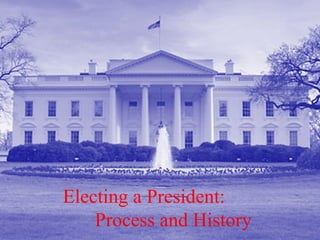
Path to Presidency
- 1. Electing a President: Process and History
- 3. How did this process get started? The Constitution – what does it say about the presidential election? Who elects the president? Indirect election – Electoral College Why do we have an Electoral College? How does it work? What are some criticisms? Why hasn’t it been changed?
- 4. Rationale for such a system at the Constitutional Convention Poor communication – common people would lack essential information Desire to have the “best” people select the President A compromise by those who wanted direct election and those who wanted the Congress to elect the President
- 5. Allotment of electoral votes to states Each state has as many electoral votes as it has members in Congress Minimum # = 3 Washington, D.C. has 3 votes (23rd Amendment) Total = 538 California has the highest number – 55 Washington will have 12 (up from 11 in the previous election)
- 6. Selection of Electors Candidate with most popular votes (only a plurality is needed) wins all of that state’s electoral votes (winner-take-all) – concentration of campaigning in large, competitive states Emphasis on “swing” states – FL, OH, PA Electors meet in respective state capitals in December to cast ballots
- 7. Winning the election • Majority of electoral votes (270) needed to win • If no candidate has a majority (this is what the Founders thought would happen most of the time. They did not anticipate the development of the two- party system): − House selects President from among top 3 candidates − Each state has 1 vote − Done in 1800 and 1824 − Senate selects V.P. from among top two candidates
- 9. Criticisms President can be elected with only a plurality rather than a majority (of popular votes) especially with presence of strong 3rd party Faithless Elector – no federal law requires electors to vote the way they are “supposed” to vote (most states do have a law) Small states proportionately overrepresented (Wyoming – 3 electoral votes – 1 vote per 166,666 people, California – 55 electoral votes – 1 vote per 600,000 people) Small states overrepresented (if election goes to the House, Wyoming has same voting power as California) Inhibits development of third parties (Perot won 19% popular vote but no electoral votes)
- 11. Alternatives Direct election: each person’s vote would count as much as every other person’s vote District system (candidate who wins a congressional district wins that district’s electoral vote). Overall winner in a state would get the two “bonus” electoral votes by virtue of its Senate seats Proportional system (candidate gets same % of electoral votes as popular votes)
- 12. Why has the Electoral College system not been abolished? Tradition/reluctance to tamper with the Constitution Difficulties in amending the Constitution Opposition from the overrepresented small states
- 13. How does the process of selecting a president work today? The Path to the Presidency today • Invisible primary: unofficial campaigning done by unofficial candidates • Declaration of candidacy • Nomination phase • Fall campaign • Election day • Meeting of electors • Formal election • Inauguration day
- 14. Nomination Phase • Some states use a caucus to determine the party candidate for president – Local caucuses – district convention – state convention – national convention. Each level selects delegates to attend higher level – Importance of Iowa: 1st state to hold caucuses each presidential election year – chance for candidate to build momentum for future caucuses and primaries – The State of Washington uses a caucus system
- 16. • Other states use presidential primaries as method of selecting a nominee. Increased use of primaries in last 30 years. – Voters vote for candidates and state parties select delegates to attend convention either on proportional basis (Democratic Party) or winner-take-all (Republican Party). – Importance of New Hampshire: the first state to hold primary each presidential election year – chance for candidate to build momentum for future caucuses and primaries. – Front-loading trend: primaries are held earlier and earlier. The idea of Super Tuesday where many southern states held their primaries early in the election season, has morphed into a situation where more and more non-southern states are moving up the dates of their primaries (Super Tuesday not as significant).
- 18. • National Convention – Selection of presidential nominee: a mere formality since the winner is known well ahead of time – emphasis on “image” instead of “scrimmage” – ratification rather than nomination – Selection of v.p. nominee • Chosen by presidential nominee and rubber stamped by convention • Balancing the ticket – Use of superdelegates by Democrats – Party platform – Reconciliation and unification of party by end of the convention • Inspiring speeches by prominent politicians and videos promoting the candidates and their families, speeches by v-p nominee and presidential nominee
- 19. • Analysis of presidential nominating system – Pro • Highly participatory: caucuses, primaries, conventions • Potential to be more representative • A testing ground for candidates. Weeds out weaker candidates. – Con • Low rates of turnout • Too lengthy • Does not test candidates for qualities they need as president. Too much emphasis on media game. • Front-loading has adversely affected states with later primaries. In essence, these states have no say in who is nominated • Voters in primaries tend to be better educated and more affluent than those in general elections • Delegates at caucuses and conventions tend to be unrepresentative: more ideological, more activist, more educated, less moderate, much more wealthy. (“Selectorate” replaces the “electorate.”)
- 20. Key Dates in this year’s presidential election • Republican convention week of August 27 (Tampa) • Democratic convention week of September 3 (Charlotte) • November 6 – election day! • Meeting of Electors – Monday, December 17 • Inauguration day – January 20, 2013
